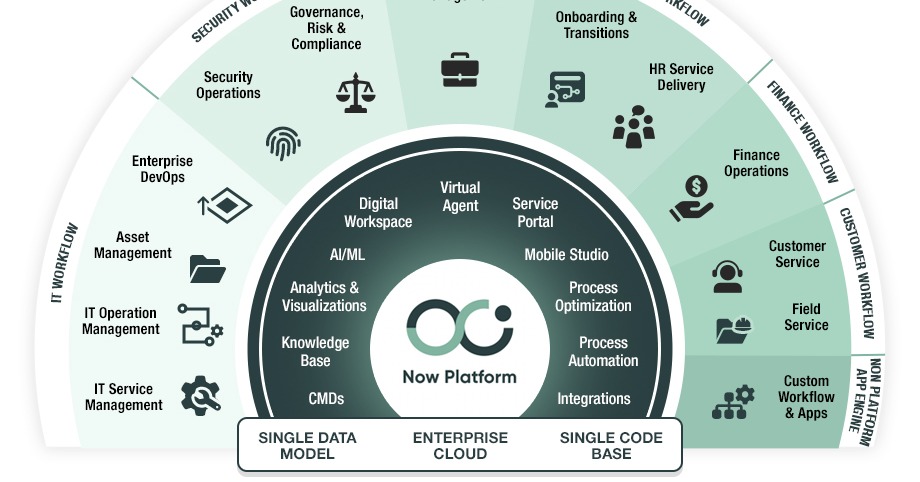ServiceNow Approved: Combine ITSM and ITOM and work more efficiently
With Service Operations, we are merging the ITSM and ITOM workflows and fostering comprehensive infrastructure management, synchronizing workflows...

Stepping Up Your Service Management: Why Organizations are Moving from Cherwell to ServiceNow
For organizations relying on Cherwell Service Management, the platform has likely been a cornerstone of IT operations. However, in my work as a ServiceNow architect at The Cloud People (TCP), I consistently see that modern digital demands more. Critically, with Cherwell Service Management's End of Life planned for December 31, 2026 , many clients are urgently seeking to transition from older systems.
ServiceNow is the answer. This cloud platform offers a broad ecosystem beyond traditional ITSM , including IT Operations (ITOM), IT Business (ITBM), and Customer Service Management (CSM). It's a strategic upgrade, in my view, bringing better user experiences, improved reporting, and greater efficiency, leading to faster service delivery. This article, drawing from my experience and TCP's insights, explores this transition and its benefits.
While Cherwell Service Management is capable, our clients at The Cloud People often explore ServiceNow due to several factors:
Cherwell Limitations I've Observed:
EOL Urgency: The impending Cherwell EOL (December 31, 2026) necessitates a planned transition.
Scalability: Cherwell can struggle with rapid user and data growth.
Integration: Connecting Cherwell with other enterprise systems can be intricate.
Platform Scope: It primarily focuses on ITSM, limiting broader capabilities.
User Experience: The interface can feel less modern than ServiceNow's.
Automation: Automation capabilities may not be as far-reaching or AI-driven as ServiceNow's.
The Allure of ServiceNow, as We See It at The Cloud People:
Cloud-Native Scalability: Designed for high performance and growth.
Simplified Integration: APIs and many pre-built connectors make integration easier.
Broad Ecosystem: Offers applications beyond ITSM, unified on the Now Platform.
Modern UI: Provides an intuitive experience for all users.
Advanced Automation: Its workflow engine, with AI/ML, enables sophisticated automation.
For me, and for The Cloud People, ServiceNow helps overcome these limitations, providing a future-ready platform.

Migrating to ServiceNow brings many advantages to IT and business operations, as I've seen with clients at The Cloud People:
Improved User Experience: ServiceNow's modern interface, user-friendly portals, and mobile access enhance convenience and adoption.
Better Visibility & Reporting: Its analytics offer real-time insights and integrate with tools like Power BI.
Increased Process Efficiency: Workflows and automation streamline IT processes, reducing manual effort and improving resolution times. I recall a client seeing a 30% MTTR reduction with auto-routing.
Better Scalability: ServiceNow's cloud architecture scales easily, ensuring consistent performance with growth.
Platform Extensibility: The Now Platform's low-code/no-code capabilities allow building custom applications and workflows beyond ITSM.
These benefits lead to a more efficient, agile, and user-centric service management approach, a goal we strive for at The Cloud People.

From my perspective as a ServiceNow architect at The Cloud People , a strategic and well-executed plan is essential.
Key planning considerations I emphasize:
Define Scope & Objectives: Clearly state what you want to achieve with ServiceNow, guiding the journey.
Data Strategy: Determine what data to migrate (e.g., CMDB, users) and for historical data, consider cleansing and transformation.
Integration Needs: Identify all systems needing integration with ServiceNow and plan connections.
Change Management: Plan for user impact through communication and training, as this is a 'people project'.
Migration Approach: Choose between a phased rollout (often preferred) or a big bang cutover, weighing risks.
Process Optimization: Decide if you'll directly migrate Cherwell processes or re-engineer them for ServiceNow's strengths.
Training: Early training is vital for user adoption.
Leveraging ServiceNow native tools:
Import Sets & Transform Maps: Use these for flexible data migration from Cherwell exports.
IntegrationHub & APIs: Connect ServiceNow to other systems for data flow.
Automated Test Framework (ATF): Useful for testing configurations and migrated data, giving confidence.
By applying these approaches and tools, you can navigate your migration effectively.

As a ServiceNow architect, I've guided organizations through platform transitions. In one project I led, a key driver for migration was the impending Cherwell Service Management End of Life on December 31, 2026. This organization had highly customized Cherwell processes, making direct data migration difficult. They chose a cutover strategy for incidents and service requests: closing existing tickets in Cherwell and starting fresh with new processes and new tickets in ServiceNow.
1. Establishing the Core Foundation:
Migrated user and group structures, ensuring proper roles and permissions.
Set up a core CMDB, migrating foundational CIs (servers, networks, applications) and leveraging ServiceNow's discovery.
Configured essential ServiceNow platform elements like organizational structures and business services.
2. Transitioning Core ITSM:
Designed and implemented streamlined Incident Management processes in ServiceNow, with all new incidents created there.
Rebuilt their Service Catalog for user-friendliness, with all new requests handled in ServiceNow.
Established initial integrations for identity and monitoring.
3. Expanding ITSM and CMDB Depth:
Optimized Problem and Change Management processes in ServiceNow, starting new records there.
Migrated their knowledge base to ServiceNow for easy access, understanding that historical incident detail would not be actively managed
Expanded the CMDB with more detailed CI attributes and service relationships for better IT operations.
The Outcome: The migration, driven by Cherwell EOL and a clean cutover, transformed their IT. It brought a smooth transition, improved user experience, and better operational efficiency. The organization now has a scalable, unified platform for future growth, demonstrating EOL as an upgrade opportunity
For me, and for us at The Cloud People, moving from Cherwell to ServiceNow is a strategic upgrade. I've seen firsthand how ServiceNow addresses limitations of older systems, offering better user experiences and automation.
This transition, in my view, brings greater efficiency and visibility, creating a future-ready service management approach on a unified platform. If you're looking to elevate your operations, ServiceNow offers a compelling path forward. And if you're ready to explore that path, we at The Cloud People are here to help guide you.

With Service Operations, we are merging the ITSM and ITOM workflows and fostering comprehensive infrastructure management, synchronizing workflows...

IT Service Management is an approach to supporting and designing IT services in use by many organizations. This article attempts to give a short...

In today's technology-driven business landscape, selecting the right software platform is crucial. Two prominent names in the cloud-based software...